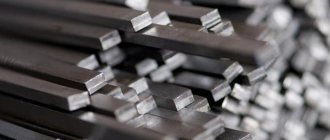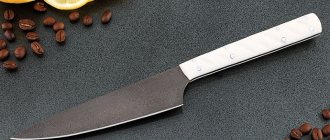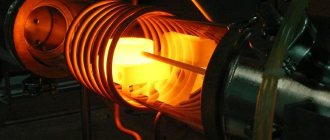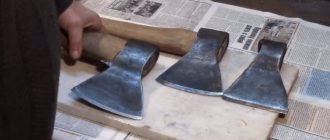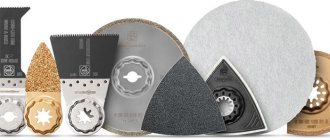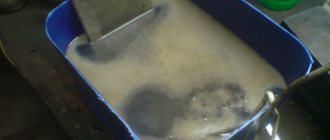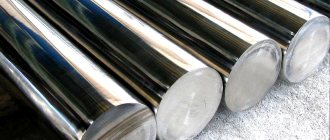In making knives, the most important thing is the material from which the blade is made. Widely used for these purposes from the middle of the last century to this day remains X12MF - a steel whose characteristics are suitable for the manufacture of parts for machines, gears, punches and for cold forging of knives, saws, cutters and cutters. Manufacturer Bob Dozier used this metal all his life to make knives, considering it the most worthy. An identical analogue of X12MF in America is D2 steel.
Knife made of steel X12MF.
Composition and characteristics of steel Kh12MF
According to GOST 5950-2000, X12MF is classified as alloyed ledeburite steel. Its formula includes 1.5% carbon and 12% chromium.
Decoding
The alloy marking consists of letters and numbers that indicate the properties of the steel of this grade. These components are the main ones and affect its physical and mechanical properties:
- X - chromium;
- 12 - percentage of chromium;
- M - molybdenum;
- F - presence of vanadium in steel.
Chemical composition
| C | Si | Mn | Cr | W | V | Mo | Ni |
| 1.45-1.65 | 0.1-0.4 | 0.15-0.45 | 11.0-12.5 | — | 0.15-0.30 | 0.4-0.6 | — |
The mass fraction of sulfur and phosphorus in steel should not exceed 0.030% (of each element).
Three elements that have the largest share in the structure of steel of this grade:
- Chromium. The metal remains resistant to corrosion and increases the sharpness of the cutting edge if its content in the alloy reaches 12.5%. At a higher rate, steel moves into the stainless steel category.
- Carbon. The hardness of the blade on the Rockwell scale reaches 62-63HRC due to the high presence of this element in the steel.
The hardenability of steel is increased by inclusions of molybdenum, silicon and vanadium. Thanks to these chemical elements, the metal becomes less sensitive to overheating, and the bonds between particles are strengthened. Internal stress during deformation and processing is reduced by manganese.
Silicon, nickel and copper prevent the blade from becoming brittle when tempered.
Material X12MF Chelyabinsk
Not a single production can operate without steel, be it heavy engineering or the manufacture of household electrical appliances. There are many brands of this product, as well as a large number of dispensing forms. Our company sells X12MF material in large quantities and with a minimal margin. To clarify the properties and characteristics of a particular brand, you can contact the company’s managers.
Like all products, X12MF material is purchased from leading manufacturers. Therefore, we are ready to provide a quality guarantee with full responsibility. The minimum number of intermediaries determines the low cost. Coupled with fast delivery, this enables our business partners to conduct stable and mutually beneficial cooperation.
In addition to tempering, in the form of one or another part (blank), our company carries out metal processing. All events undergo strict control for compliance with GOST and rules. The specialists of our company carry out such work as galvanizing, creating parts according to customer drawings, producing castings, manufacturing various profiles and much more.
Having the latest equipment and vast experience in our arsenal, we can offer product testing for a number of parameters, such as strength characteristics, chemical composition, alloy purity, and so on.
Each buyer is offered a huge range of products in various formats, as well as current services and works. To quickly understand and choose a product that meets your needs, you need to contact the company manager and receive detailed information on all issues of interest.
Production technology
Forged steel X12MF is produced in a hot foundry at strictly controlled temperatures up to 950°C. The canvas will become brittle during the cooling stage after casting if this regime is violated. When forged, such knife steel will crumble.
The electroslag alloy method is most often used for casting. It consists in melting the metal in baths of electrically conductive slag.
Forging blanks.
The internal particles and grains of the crystal lattice are brought to a stable state through tempering after the preliminary processes of hardening and annealing. The sheet of hot metal then releases internal stress and hardens. To achieve maximum hardness, the steel is subjected to hardening and tempering procedures several times.
After beating with a hammer, the dendritic structure becomes stable. Solid metal sheets are cut into blanks and fired in a vacuum oven again to give the desired shape. In this form they are sent to metallurgical plants.
Due to complex technological requirements, steel according to GOST cannot be cast in artisanal forges. The original alloy is produced only by trusted knife manufacturers.
Characteristics of knife steel
Before considering the properties of x12MF steel, identifying the pros and cons, it is worth familiarizing yourself with the existing characteristics of the alloy. There are several types of it, which have certain differences in the types of alloying additives, heat treatment, and rolling.
There are five main properties of steel:
- Hardness - resistance to physical influences.
- Rigidity - resistance to mechanical damage (chips, cracks). Determined by the hardness of the steel.
- Anti-abrasive, anti-adhesive resistance. The higher the hardness, the higher the quality of these properties. It also depends on the chemical composition: the higher the content of carbide and tungsten, the better the wear resistance.
- Anti-corrosion resistance - resistance to rust. This indicator has its disadvantages: it has a bad effect on the properties of the blade tip.
- Safety from “blockages” - the duration of use of the blade without sharpening.
You need to know that even the best knife steel cannot combine the high properties of all five characteristics. Only a compromise is possible in balancing stiffness with hardness.
This indicator is necessary, because you can make a product with an extremely hard blade that cuts iron, but can break simply by hitting a hard floor. Or the knife will be rigid, withstand strong bends, but will not be able to keep sharpened for a long time.
Worsman knife
Knife steel x12MF has the most optimal characteristics for making high-quality knives, although, along with positive qualities, it has some disadvantages, which we will discuss below.
Pros and cons of steel
A good knife should be strong and durable. Other indicators that affect its quality are the ease of sharpening the blade and cutting properties. In Russia, the closest analogue of the X12MF is 95X18.
This stainless alloy steel is widely used for household and industrial purposes (in the chemical industry, the manufacture of parts for hot shops of factories). Its heat treatment also requires careful adherence to the established regimes, otherwise the alloy will irrevocably lose its properties.
If you choose between 95X18 or X12MF a suitable material for making a knife, then you should start from the purposes of its use.
Comparing stainless and conditionally stainless steels is appropriate when a knife is chosen for infrequent use: hiking, for going outdoors, but not for daily needs. For these purposes, 95X18 steel, which does not rust, is better suited. It holds an edge for a long time and does not deteriorate from exposure to acids, water and dirt.
This blade is easy to care for and you don’t have to take it out of the sheath for a long time unless necessary - the blade will remain like new. The hardness of such knives is 58HRC, which is enough for cutting food, ropes, and green growth in the forest. This is a tourist, fishing or hunting weapon.
X12MF has a number of strengths and weaknesses along with 95X18 and other steels.
Advantages
- The high hardness of X12MF is indispensable in everyday life when quick and easy cutting of vegetables and fruits is required. The sharpness of the cutting edge allows you to use these knives every day in the kitchen, in the garden and outdoors, when working with wood and synthetic fabrics.
- The blade made of X12MF does not become dull for a long time and does not require special care, as it belongs to the class of conditionally stainless steel and holds the edge well. When purchasing a knife from X12MF, the owner of a knife must stock up on a diamond stone and a belt with GOI paste - this is necessary for high-quality home sharpening.
- X12MF steel is made from cheap components, as a result of which it is inexpensive. Compared to analogues made of Damascus steel, knives made of this metal are stronger, less afraid of water, more functional and have a lower cost. Availability and good cutting qualities allow us to turn a blind eye to some of the shortcomings of this grade of steel.
Knife with a blade made of steel X12MF.
Flaws
- The use of a blade made of X12MF steel as a kitchen blade shows its negative sides already after the first cutting of watery or acid-containing products. The metallic luster is washed out, and the steel surface of the blade becomes covered with streaks and stains due to poor corrosion resistance. Aesthetic imperfections do not in any way affect the cutting properties of the knife, but it will no longer be possible to polish the blade to a shiny appearance.
- On a hike, weapons from the X12MF will be useful for quickly cutting down bushes and branches. It will not become dull even under intense loads. But if the blade has not been sharpened for a long time, this procedure will not be possible in the field. Unlike steel 95Х18, which can be sharpened even on cobblestones.
- The X12MF blade does not withstand breaking loads well. If there is a strong impact with a bone or other object with high viscosity, the blade will break or a chip will form on the blade.
Features of steel
The main products made from X12MF alloy are knife blades. And the specific addition of metals to the alloy determines its place of application. For example, chromium is added to the alloy discussed in this article. As a percentage of other metals in this grade, steel is only twelve percent.
Many people are interested in whether X12MF steel rusts or not. Yes, the knife is prone to rust in the kitchen, where the knife will constantly be in dampness, it has no place .
X12MF steel is more suitable for hunters. Since the addition of chromium increases the wear resistance and cutting properties of the product.
With proper care, X12MF will not rust for quite a long time. And the decoding of the name of the metal alloy means the following:
- X – addition of chromium, where the number 12 means its percentage among all other metals;
- M – it contains molybdenum;
- F – vanadium.
Scope of steel application
During the Soviet period, alloy steel X12MF was indispensable in machine production, the manufacture of electrical equipment and cold-forming tools: bodywork, molding dies, dies, rollers, cutters - and is still used for these purposes, like U12A steel, which is similar in composition.
The latter is also used in the production of surgical equipment, engraving machines, springs, parts and surfaces with a cutting edge not intended for heating.
If metal is required for the manufacture of factory parts with better toughness, more resistant to abrasion and force impacts than Kh12MF, then its preferred variety is semi-heat-resistant steel Kh12F1.
Knife with a forged blade made of X12MF steel with a leather sheath.
X12MF is used in the areas of aircraft, motorcycle and shipbuilding, the production of edged weapons, fittings and alloys, and household tools.
Tourist, hunting or tactical knives made of this steel are suitable for cutting bushes, ropes, opening cans on picnics, fishing or hunting, in survival conditions. Folding knives will be useful to their owner in solving small problems in the workshop and at home.
Price
The popularity of X12MF steel exists due to its availability and the possibility of using recycled materials.
It is not easy to give more information than there is about the X12MF steel grade, which has been known for 90 years, since the times of the Soviet Union. Over these decades, information about it has been repeatedly given in periodicals in the most expanded format; there is a lot of specialized literature. Used by most of our knife makers. The reason for this popularity is due to the affordability of steel and the stable quality of manufactured products.
Read also: Iron-carbon metastable diagram
X12MF steel was created by Soviet engineers for the needs of Soviet industry in the 30s of the 20th century. Initially intended for metal processing by stamping. According to the purpose, the biochemical component of the alloy and the entire technological process were developed.
Ratnikovsky knife
Later it was found that the characteristics of the alloy already introduced into production corresponded to the production of edged weapons on an industrial scale. Steel X12MF had all the necessary properties:
- appropriate viscosity;
- stable anti-corrosion properties;
- excellent performance on compression, elasticity, hardness and rigidity.
Therefore, in addition to industrial use, the alloy began to be used for knives made for special forces. For example, military personnel of the NKVD troops were armed with these weapons.
Rules for the care and operation of knives made of steel X12MF
Weapons made of X12MF steel must be used and stored carefully to extend their service life. The sharper the blade, the easier it becomes dull. For knives made of metal of this brand, the optimal sharpening angle is 35 degrees.
For long-term use of edged weapons, storage and precautions should be taken into account.
- If the knife was used as a lever, the base of the handle could easily become loose or the blade could break. You cannot apply force to the butt and try to cut through hard and blunt objects with it.
- With frequent use in contact with acid and alkali, pitting corrosion actively appears on the blade, which spoils its appearance and leaves stains. It is necessary to polish the knife every six months before dark spots on the surface become noticeable. Fine-grained diamond belts are used for this purpose.
- The knife should be washed, wiped dry and lubricated with mineral oil, Vaseline or Ballistol after each use.
- The handle requires regular cleaning with antibacterial agents. To avoid the appearance of fungus on a wooden butt, you need to treat it with an antiseptic. The metal analogue of the handle requires the same care as the blade of a knife.
- The blade should be kept in a sheath if used infrequently. This is another way to protect the sensitive blade from corrosion.
Chemical composition
This X12MF steel is very diverse in composition and is rich in different types of metals. It has no analogues among other alloys. The following is the chemical composition of X12MF:
- Chrome – 12%. Added to improve cutting properties and wear resistance.
- Molybdenum - 0.6%. The viscosity and hardenability of the metal increases. If the concentration is too high, the durability decreases.
- Carbon - 1.6%. Gives hardness. Steel becomes wear-resistant.
- Vanadium - 0.3%. Reduces the sensitivity of steel to overheating.
- Silicon – 0.4%. Provides resistance to tempering during heat treatment.
- Copper – 0.3%. Strengthening.
- Manganese – 0.45%. When manganese is added, the alloy is less subject to warping when it is hardened.
- Nickel 0.35%. Prevents the formation of carbides.
- Phosphorus – 12%. Adds plastic qualities.
- Sulfur – 0.3%. Improves elasticity.
The percentage is indicated in the maximum values of its presence in steel. In fact, it can range from one tenth to four tenths of a percent of a given metal content. Each of the metals affects a certain property of X12MF.
Mechanical characteristics
In terms of mechanical characteristics, X12MF steel has the following advantages:
- High strength.
- Good cutting ability.
- High corrosion resistance.
- Durability.
Alloy steel X12MF is created in strict accordance with GOST and TU requirements.
Technological properties
Steel is an alloy of carbon and iron. And this alloy is made by adding many more metals, which were listed above. Therefore, X12MF is very capricious in processing. Characteristics of X12MF:
- Hard to forge.
- It is subjected to complex heat treatment, since it is necessary to maintain extremely precise temperatures of tempering, holding and other parameters.
- It is hardened at a temperature of 950 degrees Celsius. Overheating should not be allowed. Since excessive temperature greatly affects the structure of the alloy, making it more brittle.
- Has a hardness of up to 64 HRC.
Despite the fact that it is very difficult to make piece goods from this steel, there are still blacksmiths who make excellent knives. Thanks to the properties of steel, especially the presence of chromium (X12), the resulting products are famous for the strength and sharpness of the blade. These characteristics of Damascus steel knives allow you to instantly cut the flesh of a killed animal. For a hunter, this is simply an excellent weapon.
physical characteristics
Due to its physical properties, this grade of stainless steel X12MF is not intended for throwing or testing for bending. If during production the rules of hardening and maintaining temperature accuracy were not followed, then such an oversight will have a bad effect on the hardness of the alloy. The blade of the knife can be easily broken.
A product made from this alloy will serve its owner for a long time if two conditions are met:
- All technologies were followed during production.
- The owner carefully monitors and cares for his instrument.
And also X12MF can:
- Easy to carry out planing and polishing work (used in woodworking factories).
- Does not require frequent sharpening.
- It can easily withstand 40-degree frosts and the same heat.
- When the metal is exposed to high temperatures, the steel does not deteriorate or warp.
- Long service life. This property of this steel is due to the presence of vanadium.
- A person can sharpen the tool himself.
- Has resistance to corrosion.
- It does not break if the alloy is homogeneous in structure.
Areas of use
This type of steel and products made from it are used both in everyday life and in industry. In everyday life, X12MF is famous for its excellent and wear-resistant knife blades. Knives made of this steel can be used both at home and while hunting or fishing. Sharp steel easily cuts through delicate green shoots, reeds, and thin branches. The main thing is not to get carried away and not to cut bones with it, and not to use it as an ax. Because chips then appear on its canvas. This will ruin not only the aesthetics of the blade, but also its functionality.
Knives made from X12MF tool steel require a special approach to caring for them. The knife blade is treated with mineral oil. To sharpen or straighten it, fine-grained diamonds, leather belts and GOI paste are used. The correct sharpening angle is the basis for its sharpness and wear resistance. It is equal to thirty-five degrees in tilt.
In addition, below are some recommendations for caring for such knives:
- After use, the knife is washed under running water. Then it is wiped with a paper napkin. Because this particular product absorbs moisture well, unlike fabric. And the blade should under no circumstances be connected for a long time to water elements for apartment buildings. Since it contains chlorine, which will definitely interact with this alloy. The blade will become stained and may darken.
- In order for it to regain its original appearance, it must be lubricated with a special compound, which is sold in a gun store.
- It needs to be polished once every four months.
- Do not use a dishwasher to clean it. Otherwise, the blade may become dull or even damaged.
- It must be stored in special knives that came with it when sold.
- The wooden handle must be treated with antiseptics so that it is not damaged by bacteria and fungi, for which it is a favorite food. And, if the handle is metal, then it is necessary to eliminate chips and scratches. If rust appears in these places, it will soon reach the blade.
